

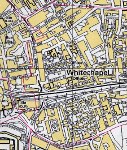 The
west side of Mansell Street transferred from Tower Hamlets to the City
of London following a 1994 ward boundary review, but remains in the
parish up to Alie Street, as the parish boundary map right shows. Before the review, the boundary ran through some premises, whose tenants paid split rates to both authorities. [Far right is Weller's 1868 map, showing in red the railway viaducts.] Sites now in the City but within our parish include
The
west side of Mansell Street transferred from Tower Hamlets to the City
of London following a 1994 ward boundary review, but remains in the
parish up to Alie Street, as the parish boundary map right shows. Before the review, the boundary ran through some premises, whose tenants paid split rates to both authorities. [Far right is Weller's 1868 map, showing in red the railway viaducts.] Sites now in the City but within our parish include
The architectural writer Giles Worsley (no relation of Dr Lucy Worsley) wrote'Witnesses to the City's Wealth: the Plight of
nos.57-59 Mansell Street' in Country Life
179 (1986), which is worth quoting in full as tribute to his work (he
died prematurely ten years later) and by way of background:
|
Mansell Street was laid out by the Leman family, a typical example of how a cadet branch of a gentry family came to London, made its fortune in trade, produced a sheriff and Lord Mayor of London, bought land in the country, first as an investment and then as a seat, became high sheriffs and MPs in the country, and eventually gave up all direct links with the City to return to being country gentlemen. Sir John Leman, who was the first to make his fortune in the City, was Lord Mayor in 1616. Among the land he bought was the manor of Barnes or Goodmansfields on the eastern outskirts of London. Childless, he left the bulk of his estate, including his London property, to his youngest nephew William, who was made a baronet in 1665 and increased his share of Goodmansfields by marrying Rebecca Prescot. It was probably his son, the second Sir William, who died in 1701, who first laid out Goodmansfields, including Mansell Street. The exact date when he did so is unclear, hut it must have been between 1682, when William Morgan's map shows Goodmansfields undeveloped, and 1700, when Morden, Lea and Browne's map shows it covered with housing. Just outside the City boundaries, on a bread street that had not then been extended at its two ends to become the busy thoroughfare it is today,. Mansell Street must have attracted some rich tenants; certainly, many of the building plots were much wider than usual. One of the original double-fronted houses is known from a 19th-century photograph in the National Monuments Record. Six bays wide with the end bays projecting forward as at Schoenberg House in Pall Mall, it has a considerable dignity. By the 1740s, however, its wooden modillion cornice, hipped roof, flush sash windows and projecting closets must have seemed very old-fashioned. According to Neve's Builder's Dictionary of 1736: 'Few houses ... last longer than the ground lease' [ed: a remark also quoted by Summerson]. This was the fate of the houses on the site of nos.57-59 Mansell Street. The original building lease was probably only 42 years, the old houses were torn down, and new, grander buildings took their place. They were not the only new houses in the street. In 1924 the Geffrye Museum received some very fine contemporary panelling from 63 Mansell Street, which was then being demolished. Highly architectural, with an elaborate cornice, it is the only other relic of the street's great days. Nos. 57-59 Mansell Street are exceptional in the elaboration of their façades. London terrace-houses, even the grandest, are normally very plain, and became more so as the 18th century progressed, The Mansell Street façades represent a trait often associated with City merchants' houses, being both rather old-fashioned in design compared to the West End, and more exuberant in their use of architectural motifs. The two houses were originally almost identical, but the years have taken their toll. Heavy stone piers, originally supported by iron railings, immediately distinguish them, setting them back from the street as if in their own courtyard. Behind the central piers lies the doorcase, with freestanding Doric columns supporting a broken pediment in front of a rusticated archway. The doorway is so wide that it needs double doors. The central bay breaks forward to emphasise the centre of the house, which is further distinguished by the stone architraves of the windows, and by the stone panels above and below the windows. One of these panels lies, in a distinctly Mannerist fashion, within the broken pediment of the doorcase, so that the areas of the window and the door interpenetrate. The ends of the houses are marked by a vertical band of channelled masonry, each floor is distinguished by an increasingly emphatic string-course, culminating in the cornice, and the windows are emphasised by stone keystones. Today the two houses lie empty. Both have suffered terribly, no.57 having lost its ground-floor windows, no.59 its doorcase, ferns grow from the façades, and the brickwork pf the parapet is perilous. Internally little remains of the latter, but the former still retains most of its staircase and the panelling round the external walls, although the internal partitions have gone. In January last year, the architects Treherne and Norman, Preston and Partners presented a planning application for the redevelopment of 57-59 Mansell Street and the neighbouring buildings. In their scheme, which had been under discussion with Tower Hamlets Council since 1982, only the façades of the two houses were to be preserved. When the framework of the scheme with the application for outline change of use was submitted, it was rejected by the council. Among other objections, the developers were told that they would have to retain the structure as well as the façades of the houses. The developers have lodged and appeal, believing the rejection to be unreasonable. They would prefer, however, to continue informal negotiations to produce a scheme that would be acceptable to both parties without the expense of an appeal. Tower Hamlets, anxious to preserve the houses, will accept their conversion into offices. Treherne and Norman have indicated that they are prepared to restore them. However, they feel that the resulting expense would be viable only if the rest of their scheme were accepted, and that to do so the council's requirements for the site, in particular over the provision of light industrial space, would have to be relaxed. Developers and council are therefore agreed that the houses and their interiors can and should be saved. Careful conversion into offices is the only feasible way in which this can be done. The problem is to agree a formula for the whole site which would make this possible. The wealth of the 18th-century aristocracy has left its architectural mark throughout London and the country. Little remains, however, to remind us that the real wealth of Georgian England derived from trade. Nos. 57-59 Mansell Street are lone witnesses to the City's wealth, and for this reason they are among the most important surviving early 18th-century domestic buildings in London. They cannot be left to rot for want of a suitable scheme. |

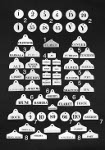
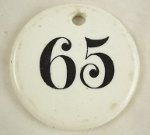

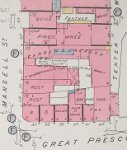
 The
company was established in 1798 (and incorporated a century later),
making its name with wood, and later metal, wine bins to Farrow's
designs - their older wine-racks are now 'collectables' for
contemporary kitchens. Left is an advertisement from 1868. Their
premises were at 18,17 & 16 Great Tower Street [where their head
office remained], 1
Harp Lane, and their factory at 57 & 58 Mansell St - left on Goad's 1887 insurance map - with a West End
branch in Haymarket. Later addresses were 24 Eastminster and 91 Mansell
Street, and 41-43 Prescot Street; there was also a branch in Paris.
The
company was established in 1798 (and incorporated a century later),
making its name with wood, and later metal, wine bins to Farrow's
designs - their older wine-racks are now 'collectables' for
contemporary kitchens. Left is an advertisement from 1868. Their
premises were at 18,17 & 16 Great Tower Street [where their head
office remained], 1
Harp Lane, and their factory at 57 & 58 Mansell St - left on Goad's 1887 insurance map - with a West End
branch in Haymarket. Later addresses were 24 Eastminster and 91 Mansell
Street, and 41-43 Prescot Street; there was also a branch in Paris. 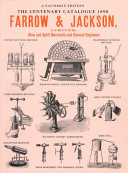
 The 1898 centenary catalogue [left] was
re-published (edited by Bernard M Watney) to mark their bicentenary.
This shows a wide diversity of goods, including their patent corkscrew
and ceramic wine bottle labels (including most, but not all, of those
displayed above right). By 1914
they were described as mechanical engineers and manufacturers of wine bins and cellar requisites for the
brewing, mineral water and refrigerating trade with a staff of 80. A 1938 advertisement [right] shows a 'rotary pyramid machine' for aerating bottled water - used in the Royal Navy, and will be found convenient for Country Houses, Shooting Quarters, etc. The company diversified into many kinds of modern equipment in partnership with other providers, and is now described as Wine and Spirit Merchants and General
Engineers, Manufacturers of Iron Wine Bins, Cellar and Bar Fittings,
Bottle Wax, Tapps etc., Mineral Water and Beer Carbonating Machinery,
Brewers' and Bottlers' requisites, American iced drinks and bar
appliances etc.
The 1898 centenary catalogue [left] was
re-published (edited by Bernard M Watney) to mark their bicentenary.
This shows a wide diversity of goods, including their patent corkscrew
and ceramic wine bottle labels (including most, but not all, of those
displayed above right). By 1914
they were described as mechanical engineers and manufacturers of wine bins and cellar requisites for the
brewing, mineral water and refrigerating trade with a staff of 80. A 1938 advertisement [right] shows a 'rotary pyramid machine' for aerating bottled water - used in the Royal Navy, and will be found convenient for Country Houses, Shooting Quarters, etc. The company diversified into many kinds of modern equipment in partnership with other providers, and is now described as Wine and Spirit Merchants and General
Engineers, Manufacturers of Iron Wine Bins, Cellar and Bar Fittings,
Bottle Wax, Tapps etc., Mineral Water and Beer Carbonating Machinery,
Brewers' and Bottlers' requisites, American iced drinks and bar
appliances etc.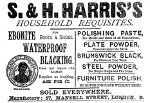
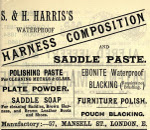

 S. & H. Harris manufactured a wide range of blackings,
polishes and pastes, especially for leatherware (including some
products for women equestrians). They were well-established by the time of the Great
Exhibition of 1851 at which they exhibited. One senior staff member in the following years was Alfred Hennel Covernton
(1836-1901) whose family had emigrated to Canada when he was a child; he
returned to England around 1861, and spent the rest of his working life
with the firm, as a blacking and polish manufacturer, living in Highbury Park, Aberdeen Park and latterly Lewisham. (The firm itself later had premises in north London.) Right: no.2 Black Harness Oil and Coach & Gig Harness Liquid.
S. & H. Harris manufactured a wide range of blackings,
polishes and pastes, especially for leatherware (including some
products for women equestrians). They were well-established by the time of the Great
Exhibition of 1851 at which they exhibited. One senior staff member in the following years was Alfred Hennel Covernton
(1836-1901) whose family had emigrated to Canada when he was a child; he
returned to England around 1861, and spent the rest of his working life
with the firm, as a blacking and polish manufacturer, living in Highbury Park, Aberdeen Park and latterly Lewisham. (The firm itself later had premises in north London.) Right: no.2 Black Harness Oil and Coach & Gig Harness Liquid.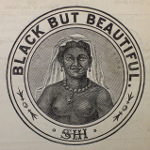 Their 'black but beautiful' logo [left] may raise eyebrows today, but is a biblical reference (I am black, but comely - Song of Solomon 1.5, AV) and also a reminder of the fact that the
Harris family had strong links with the Bahamas. Sir George David Harris
JP (1827-1902, latterly of Inverness Terrace) had been a member of the Colonial Parliament of the Bahamas,
and in 1854 married Eliza Margaret, daughter of the Hon. Henry
Adderley (b. Long Island 1803, d. London 1875; his wife Mary Ann
Perpall was from a Minorcan family which had relocated to Nassau, 'New
Providence' - as it then was). Henry and his son Augustus John
(1835-1905) were merchants and politicians in the Bahamas. The Harrises
exported their products to the region, and in 1861, from 27 Mansell
Street, wrote to Earl Russell (then Foreign Secretary, later Prime Minister):
Their 'black but beautiful' logo [left] may raise eyebrows today, but is a biblical reference (I am black, but comely - Song of Solomon 1.5, AV) and also a reminder of the fact that the
Harris family had strong links with the Bahamas. Sir George David Harris
JP (1827-1902, latterly of Inverness Terrace) had been a member of the Colonial Parliament of the Bahamas,
and in 1854 married Eliza Margaret, daughter of the Hon. Henry
Adderley (b. Long Island 1803, d. London 1875; his wife Mary Ann
Perpall was from a Minorcan family which had relocated to Nassau, 'New
Providence' - as it then was). Henry and his son Augustus John
(1835-1905) were merchants and politicians in the Bahamas. The Harrises
exported their products to the region, and in 1861, from 27 Mansell
Street, wrote to Earl Russell (then Foreign Secretary, later Prime Minister):| My Lord, We beg most respectfully to approach your Lordship. It has been our practice ever since the establishment of mail steam-ship communication between New York and Nassau, Bahamas, to ship general merchandize from London to New York for re-shipment to Nassau. Our consignments by the two last mail steamers from London, amounting to some thousand pounds in value, have been, and we believe still are, detained in New York by order of the Government of the United States, who refuse to allow them to be sent to their destination unless bonds are given that, after arriving at Nassau, the goods shall not be re-shipped to the Confederate States.We feel both ourselves and our correspondents at Nassau deeply aggrieved by this interdict, which appears to us tyrannical and unreasonable: for we affirm that when goods are sold in an open market, the vendor cannot possibly be called upon to be answerable for their final destination. It is quite true that before the departure of our property, it was rumoured that the Government of the United States might possibly prevent the transhipment there of goods intended for Nassau, New Providence. But this was made known to us only after many of the goods in question were actually on board the steamer. We further assure your Lordship that we immediately examined our orders, and kept back every article which was at all likely of being destined for the Southern States, and were careful to forward only such goods as are commonly ordered for the Nassau market, and consumed in the port of Nassau and surrounding British Possessions.After all these precautions not to trench on the regulations of the United States, we find that, to the great loss and annoyance of the Nassau storekeepers and ourselves, our goods now lie impounded at New York. With the utmost respect we entreat your Lordship's protection and interference in this matter. Should the remedy lie within your Lordship's province, we have the fullest confidence that we shall obtain immediate redress. Should there appear difficulties in the way, then, with equal respect and solicitude. we beg your Lordship kindly to point out to us our surest legal method of redress. We have, &c. (signed) S. AND H. HARRIS |
| [The vessels] coast along the banks and reefs where the water is shallow and [the sponges] are brought to the surface by hooked poles. The day's catch is spread out on the deck so as to kill the mass of animal life ...Then the spongers go ashore and build a pen or 'crawl' of stakes close to the water's edge, so that the action of the tide may wash away the black covering ...The sponges are strung upon small palmetto strips, when they are taken to Nassau to be sold in the sponge market. On the conclusion of the sale the sponges are taken to the packing yard where they are sorted, clipped, soaked in tubs of lime-water, and spread out to dry. They are then pressed by machinery into bales, containing 100 pounds, and in this state are shipped to either England or the United States. |
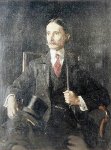 Sir
Augustus Adderley married Letitia Anne Hall, and their home (where his
daughter's husband the artist Frederick Beaumont had a
studio) was in Douro Place, Kensington. Sir George David
Harris' son was Sir Henry Percy Harris KBE (1856-1941), a barrister and
JP who chaired the London County Council in 1907-08 and was MP for
Paddington South from 1910-22. His home was in Gloucester Terrace; he
was a freemason [right - painting by William Orpen, from the Guildhall Art Gallery].
Sir
Augustus Adderley married Letitia Anne Hall, and their home (where his
daughter's husband the artist Frederick Beaumont had a
studio) was in Douro Place, Kensington. Sir George David
Harris' son was Sir Henry Percy Harris KBE (1856-1941), a barrister and
JP who chaired the London County Council in 1907-08 and was MP for
Paddington South from 1910-22. His home was in Gloucester Terrace; he
was a freemason [right - painting by William Orpen, from the Guildhall Art Gallery].|
An efficient Out-door Assistant is required for a Country practice.
Diploma not absolutely essential, provided testimonials are otherwise
satisfactory. Liberal salary given. - Address, C, care of S. and H. Harris, 27 Mansell-street, Goodman's-fields, London |
 Noah Edward Lewis
(Levi), alias Knight, c1760-1830, having travelled in Germany and
France (where he was suspected of being a British agent during the
Napoleonic Wars), was appointed in 1805 a Paymaster in the 8th Royal
Veteran Battalion, and took the tenancy of 21 Mansell Street at a rent of £2 10s., listed two years later at this address as merchant. He was later based at Fort Cumberland and Green
Terrace, Kingston Cross in Hampshire. In 1812 he was acquitted of
conspiracy to defraud one Edward Gibson of £5,000 (possibly using the
alias 'Knight') while his co-defendants Augustus and William Whitaker
were convicted. But the following year he was court-martialled for
embezzling moneys drawn between 1807-12, including 'bar, baggage and
forage money' for the expedition of three companies of the battalion to
Heligoland - ‘more or less’ £2280 2s 6½d (of which for some reason he
was excused £160), and dismissed from the service; in 1814 he was in
the King's Bench Prison. He re-surfaced some years later, living at
Melina Place, Westminster Road, giving evidence against the integrity
of Sir Thomas Champneys in 1823, and acting as accountant for a
bankrupt jeweller. He married Frances (Fanny) - they had at least six
children, one of whom (Catherine) was baptized as a Roman Catholic; after his
death Fanny lived at Woburn Place, Russell Square with Sophia, another of their daughters, until her death in 1850.
Noah Edward Lewis
(Levi), alias Knight, c1760-1830, having travelled in Germany and
France (where he was suspected of being a British agent during the
Napoleonic Wars), was appointed in 1805 a Paymaster in the 8th Royal
Veteran Battalion, and took the tenancy of 21 Mansell Street at a rent of £2 10s., listed two years later at this address as merchant. He was later based at Fort Cumberland and Green
Terrace, Kingston Cross in Hampshire. In 1812 he was acquitted of
conspiracy to defraud one Edward Gibson of £5,000 (possibly using the
alias 'Knight') while his co-defendants Augustus and William Whitaker
were convicted. But the following year he was court-martialled for
embezzling moneys drawn between 1807-12, including 'bar, baggage and
forage money' for the expedition of three companies of the battalion to
Heligoland - ‘more or less’ £2280 2s 6½d (of which for some reason he
was excused £160), and dismissed from the service; in 1814 he was in
the King's Bench Prison. He re-surfaced some years later, living at
Melina Place, Westminster Road, giving evidence against the integrity
of Sir Thomas Champneys in 1823, and acting as accountant for a
bankrupt jeweller. He married Frances (Fanny) - they had at least six
children, one of whom (Catherine) was baptized as a Roman Catholic; after his
death Fanny lived at Woburn Place, Russell Square with Sophia, another of their daughters, until her death in 1850.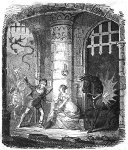 Among the various printers in the area specialising in work combining English and Hebrew was John Wertheimer at no.58 [see above on numbering]. They produced, for example, the introductory lecture of Hyman
Hurwitz as Professor of Hebrew Language and Literature in the University of London in 1828. They were also based at West Street Finsbury Circus / Circus Place, London Wall, and in 1840 were granted a patent for certain improvements in preserving mineral and vegetable substances & liquids. In 1827 they printed an edition of a translation of some of Grimm's Fairy Tales, with illustrations by I.R. Cruikshank [example right]
Among the various printers in the area specialising in work combining English and Hebrew was John Wertheimer at no.58 [see above on numbering]. They produced, for example, the introductory lecture of Hyman
Hurwitz as Professor of Hebrew Language and Literature in the University of London in 1828. They were also based at West Street Finsbury Circus / Circus Place, London Wall, and in 1840 were granted a patent for certain improvements in preserving mineral and vegetable substances & liquids. In 1827 they printed an edition of a translation of some of Grimm's Fairy Tales, with illustrations by I.R. Cruikshank [example right]
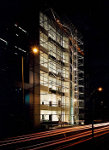

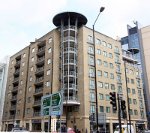 is one of more attractive office blocks in the area, described by Catherine Slessor in the Architectural Review as a technological coup de théâtre and by the current Pevsner as like a draught of pure water.
Completed in 1990, Elana Keats & Associates were the main designers
and John Winter & Associates the architects. Built as a
speculative commercial sceme providing 35,000 ft² of office space on
seven floors, it is based on an exposed reinforced concrete frame,
making pioneering use of a glazing system for double-skinned commercial
buildings
that is now commonplace today. In
1991 it won the RIBA National Award, the British Steel Award and the
CSD Minerva Award. Next door at no.87, on the corner, is the
grandiosely-titled Londinium Tower [right], 84 apartments plus commercial space, a Wetherspoon's pub Goodman's Fields at street level, and an underground car park, by David Wood Architects.
is one of more attractive office blocks in the area, described by Catherine Slessor in the Architectural Review as a technological coup de théâtre and by the current Pevsner as like a draught of pure water.
Completed in 1990, Elana Keats & Associates were the main designers
and John Winter & Associates the architects. Built as a
speculative commercial sceme providing 35,000 ft² of office space on
seven floors, it is based on an exposed reinforced concrete frame,
making pioneering use of a glazing system for double-skinned commercial
buildings
that is now commonplace today. In
1991 it won the RIBA National Award, the British Steel Award and the
CSD Minerva Award. Next door at no.87, on the corner, is the
grandiosely-titled Londinium Tower [right], 84 apartments plus commercial space, a Wetherspoon's pub Goodman's Fields at street level, and an underground car park, by David Wood Architects. 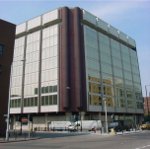 On an island site at 1 Portsoken Street is the 10-storey block Lloyds Chambers - left - with nearly 200,000 ft² of office space, completed in the early 1980s (it has changed hands several times, most recently being bought by a US/Chinese consortium).
The site was then in Tower Hamlets, who made it a condition of planning
permission that some residential accommodation was built, so Marlyn
Lodge, 50 small flats (many on short term lets) were built by Wimpey in
1983 on a site adjoining the former railway goods yard.
On an island site at 1 Portsoken Street is the 10-storey block Lloyds Chambers - left - with nearly 200,000 ft² of office space, completed in the early 1980s (it has changed hands several times, most recently being bought by a US/Chinese consortium).
The site was then in Tower Hamlets, who made it a condition of planning
permission that some residential accommodation was built, so Marlyn
Lodge, 50 small flats (many on short term lets) were built by Wimpey in
1983 on a site adjoining the former railway goods yard. 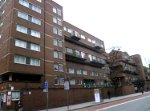
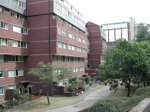

 Further along Mansell Street, an estate built by the Guinness Trust (now Guinness Partnership Group)
comprises 249 housing units in three blocks, of which Guinness Court is
the largest, with sheltered housing in Iveagh Court [front and rear -
before the Green Box was added - left]. Little Somerset Street (outside the parish) runs off Mansell Street towards Aldgate bus station. It has two pubs - the Still and Star and no.1 and the Duke of Somerset at no.15. At nos.14-16 is the Green Box Community Centre (run by Toynbee Hall) and Portsoken Health Centre (a branch of the City Wellbeing Practice on Cannon Street Road):
two shipping containers craned onto the site in a single day in 2007 by
the Corporation of London [external and internal views right]. See here for another surgery and centre constructed in similar fashion.
Further along Mansell Street, an estate built by the Guinness Trust (now Guinness Partnership Group)
comprises 249 housing units in three blocks, of which Guinness Court is
the largest, with sheltered housing in Iveagh Court [front and rear -
before the Green Box was added - left]. Little Somerset Street (outside the parish) runs off Mansell Street towards Aldgate bus station. It has two pubs - the Still and Star and no.1 and the Duke of Somerset at no.15. At nos.14-16 is the Green Box Community Centre (run by Toynbee Hall) and Portsoken Health Centre (a branch of the City Wellbeing Practice on Cannon Street Road):
two shipping containers craned onto the site in a single day in 2007 by
the Corporation of London [external and internal views right]. See here for another surgery and centre constructed in similar fashion. 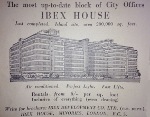
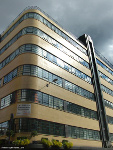
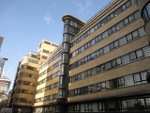 Part
of Ibex House, 42-47 Minories, lies within the parish. This H-shaped
office block by architects Fuller, Hall and Foulsham of 1935-37
(renovated 1994) is said to be the largest surviving example of Streamline Moderne,
a form of Art Deco used for many Odeon cinemas and the
Daily Express building in Manchester. At the time it had the longest
continuous glass curtain walls in the country. It is now Grade 2
listed. [Two views right, plus a 1937 advertisement]
Part
of Ibex House, 42-47 Minories, lies within the parish. This H-shaped
office block by architects Fuller, Hall and Foulsham of 1935-37
(renovated 1994) is said to be the largest surviving example of Streamline Moderne,
a form of Art Deco used for many Odeon cinemas and the
Daily Express building in Manchester. At the time it had the longest
continuous glass curtain walls in the country. It is now Grade 2
listed. [Two views right, plus a 1937 advertisement]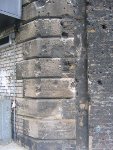
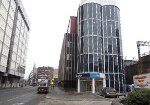
 Today Goodman's Yard is merely a street (A1211) between Minories and Mansell
Street, and a nondescript part of the one-way traffic system. Goad's 1887 insurance map of the area shows the impact of the railways on this area. Right are
Mansell Street / Goodman's Yard in 1977 and today (a Travelodge -
converted from an office block - squeezed between Goodman's Yard and
Chamber Street, hard up against the railway: as shown, buses on the 'heritage' 15 route park alongside); far right are still-visible scars
from the Blitz. Here are some 'snapshots' of its earlier history.
The eastern half lies within our parish, following the old City
boundary.
Today Goodman's Yard is merely a street (A1211) between Minories and Mansell
Street, and a nondescript part of the one-way traffic system. Goad's 1887 insurance map of the area shows the impact of the railways on this area. Right are
Mansell Street / Goodman's Yard in 1977 and today (a Travelodge -
converted from an office block - squeezed between Goodman's Yard and
Chamber Street, hard up against the railway: as shown, buses on the 'heritage' 15 route park alongside); far right are still-visible scars
from the Blitz. Here are some 'snapshots' of its earlier history.
The eastern half lies within our parish, following the old City
boundary.
 There was a glasshouse here before 1641, owned by Sir Bevis Thelwell and leased to others (more details here); it made bottles, and white and green glasses - in 1661 they provided glassware for the newly-founded Royal Society. The
City boundary, shown by a chain line in Ogilby and Morgan's post-Fire
of London map of 1676 as skirting the glasshouse (which may not be
entirely accurate) - left - demonstrates how dangerous processes were excluded from the City limits, as with the Gunmakers. Detail from Roque's 1746 map - right - also shows the boundary. It was later a soap factory.
There was a glasshouse here before 1641, owned by Sir Bevis Thelwell and leased to others (more details here); it made bottles, and white and green glasses - in 1661 they provided glassware for the newly-founded Royal Society. The
City boundary, shown by a chain line in Ogilby and Morgan's post-Fire
of London map of 1676 as skirting the glasshouse (which may not be
entirely accurate) - left - demonstrates how dangerous processes were excluded from the City limits, as with the Gunmakers. Detail from Roque's 1746 map - right - also shows the boundary. It was later a soap factory.|
THOMAS NORRIS AT YE
= Two carbines crossed ¼ |
WILLIAM PRESCOTT AT YE =
A sugar-loaf ½ |
HONEST NED SPENCER AT YE
= A roll of tobacco ½ |
| News from Goodman's Yard in the Mineries, Or, A Full and True Relation of a Most Horrid Murder: Committed by One Elizabeth Lillyman, who Stabbed Her Own Husband William Lillyman in the Left Pap, Neer the Nipple, with a Shoo-maker's Knife, Upon the 22 of June Instant, 1675, Whereof He Suddenly Died: for which Inhumane Fact She is Committed to Newgate, There to Remain Till Her Tryal at the Next Sessions : Being by the Coroners Jury Found Guilty of Petty Treason |

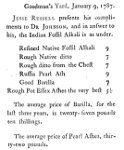 The glasshouse became Jesse Russell's soap and tallow factory: right is
a contribution he made to discussions in the Transactions of the Royal
Society of Arts in 1797 on the value and properties of Indian fossil alkali. In the previous year at the Old Bailey Robert Raw,
aged 36, was convicted of stealing 9lb of tallow, value 5s., and two
pieces of wood, value 5s., from Mr Mashiter's wharf; Russell attested
that the tallow was his, and the wood belonged to a cask of imported pearl-ash and had his mark
on it. Raw was sentenced to be Publickly whipped 150 yards upon the
quays, and confined six months in the House of Correction. In 1803 Russell served as a special juror for the King's
Bench trial of John Peltier for a libel on Napoleon Buonaparté, First
Consul of the French Republic. He was a benefactor and guardian for life of the Asylum, or House of Refuge for Orphan Girls in Lambeth - far right.
The glasshouse became Jesse Russell's soap and tallow factory: right is
a contribution he made to discussions in the Transactions of the Royal
Society of Arts in 1797 on the value and properties of Indian fossil alkali. In the previous year at the Old Bailey Robert Raw,
aged 36, was convicted of stealing 9lb of tallow, value 5s., and two
pieces of wood, value 5s., from Mr Mashiter's wharf; Russell attested
that the tallow was his, and the wood belonged to a cask of imported pearl-ash and had his mark
on it. Raw was sentenced to be Publickly whipped 150 yards upon the
quays, and confined six months in the House of Correction. In 1803 Russell served as a special juror for the King's
Bench trial of John Peltier for a libel on Napoleon Buonaparté, First
Consul of the French Republic. He was a benefactor and guardian for life of the Asylum, or House of Refuge for Orphan Girls in Lambeth - far right.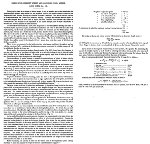
 Railway viaducts completely changed the scene. Left is a technical account of the lattice
bridge over Prescott Street and Goodman's Yard, carrying the Haydon
Square extension of the London & North Eastern Railway. Built on a curve, the report says it does not appear to have been designed with as much care
as might have been desirable, but goes on to give some calculations. Left is
also a ticket for the collection of goods from Goodman's Yard depot - for the London and South Western Railway!
There were many outings for staff of the Goodman's Yard staff (which
became part of the Great Eastern Railway); for example, the Great Eastern Railway Magazine of 1922 (the year before it became part of the LNER) reported a staff outing when a
party of about 50 travelled by the 12.25 p.m. train from Liverpool
Street to Yarmouth. Dinner and supper were served at the Garibaldi
Hotel. On Sunday morning a drive to Ormesby Broad was arranged,
returning to Yarmouth for dinner. The depot was destroyed by bombing in the Second World War.
Railway viaducts completely changed the scene. Left is a technical account of the lattice
bridge over Prescott Street and Goodman's Yard, carrying the Haydon
Square extension of the London & North Eastern Railway. Built on a curve, the report says it does not appear to have been designed with as much care
as might have been desirable, but goes on to give some calculations. Left is
also a ticket for the collection of goods from Goodman's Yard depot - for the London and South Western Railway!
There were many outings for staff of the Goodman's Yard staff (which
became part of the Great Eastern Railway); for example, the Great Eastern Railway Magazine of 1922 (the year before it became part of the LNER) reported a staff outing when a
party of about 50 travelled by the 12.25 p.m. train from Liverpool
Street to Yarmouth. Dinner and supper were served at the Garibaldi
Hotel. On Sunday morning a drive to Ormesby Broad was arranged,
returning to Yarmouth for dinner. The depot was destroyed by bombing in the Second World War.